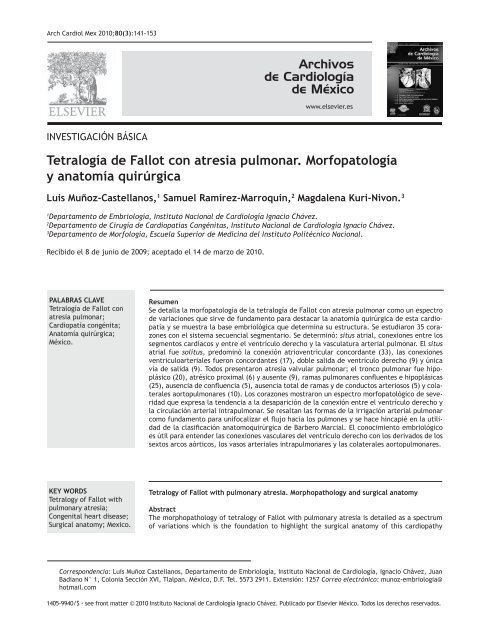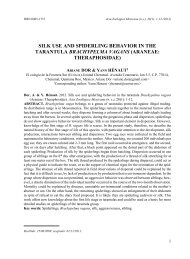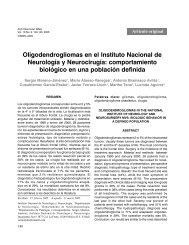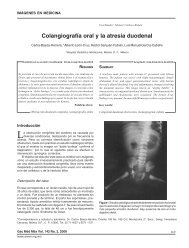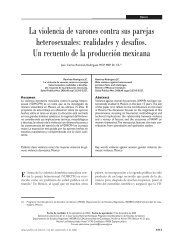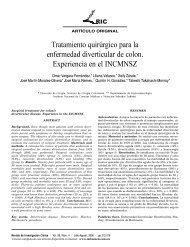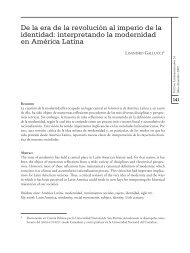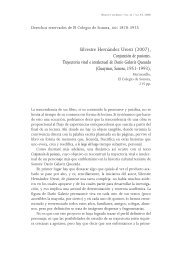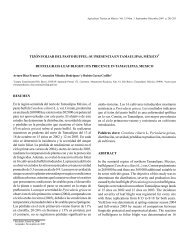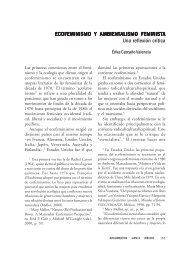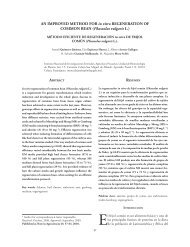TetralogÃa de Fallot con atresia pulmonar. MorfopatologÃa y ...
TetralogÃa de Fallot con atresia pulmonar. MorfopatologÃa y ...
TetralogÃa de Fallot con atresia pulmonar. MorfopatologÃa y ...
You also want an ePaper? Increase the reach of your titles
YUMPU automatically turns print PDFs into web optimized ePapers that Google loves.
Arch Cardiol Mex 2010;80(3):141-153<br />
www.elsevier.es<br />
INVESTIGACIÓN BÁSICA<br />
Tetralogía <strong>de</strong> <strong>Fallot</strong> <strong>con</strong> <strong>atresia</strong> <strong>pulmonar</strong>. Morfopatología<br />
y anatomía quirúrgica<br />
Luis Muñoz-Castellanos, 1 Samuel Ramírez-Marroquín, 2 Magdalena Kuri-Nivon. 3<br />
1<br />
Departamento <strong>de</strong> Embriología, Instituto Nacional <strong>de</strong> Cardiología Ignacio Chávez.<br />
2<br />
Departamento <strong>de</strong> Cirugía <strong>de</strong> Cardiopatías Congénitas, Instituto Nacional <strong>de</strong> Cardiología Ignacio Chávez.<br />
3<br />
Departamento <strong>de</strong> Morfología, Escuela Superior <strong>de</strong> Medicina <strong>de</strong>l Instituto Politécnico Nacional.<br />
Recibido el 8 <strong>de</strong> junio <strong>de</strong> 2009; aceptado el 14 <strong>de</strong> marzo <strong>de</strong> 2010.<br />
PALABRAS CLAVE<br />
Tetralogía <strong>de</strong> <strong>Fallot</strong> <strong>con</strong><br />
<strong>atresia</strong> <strong>pulmonar</strong>;<br />
Cardiopatía <strong>con</strong>génita;<br />
Anatomía quirúrgica;<br />
México.<br />
Resumen<br />
Se <strong>de</strong>talla la morfopatología <strong>de</strong> la tetralogía <strong>de</strong> <strong>Fallot</strong> <strong>con</strong> <strong>atresia</strong> <strong>pulmonar</strong> como un espectro<br />
<strong>de</strong> variaciones que sirve <strong>de</strong> fundamento para <strong>de</strong>stacar la anatomía quirúrgica <strong>de</strong> esta cardiopatía<br />
y se muestra la base embriológica que <strong>de</strong>termina su estructura. Se estudiaron 35 corazones<br />
<strong>con</strong> el sistema secuencial segmentario. Se <strong>de</strong>terminó: situs atrial, <strong>con</strong>exiones entre los<br />
segmentos cardíacos y entre el ventrículo <strong>de</strong>recho y la vasculatura arterial <strong>pulmonar</strong>. El situs<br />
atrial fue solitus, predominó la <strong>con</strong>exión atrioventricular <strong>con</strong>cordante (33), las <strong>con</strong>exiones<br />
ventriculoarteriales fueron <strong>con</strong>cordantes (17), doble salida <strong>de</strong> ventrículo <strong>de</strong>recho (9) y única<br />
vía <strong>de</strong> salida (9). Todos presentaron <strong>atresia</strong> valvular <strong>pulmonar</strong>; el tronco <strong>pulmonar</strong> fue hipoplásico<br />
(20), atrésico proximal (6) y ausente (9), ramas <strong>pulmonar</strong>es <strong>con</strong>fluentes e hipoplásicas<br />
(25), ausencia <strong>de</strong> <strong>con</strong>fluencia (5), ausencia total <strong>de</strong> ramas y <strong>de</strong> <strong>con</strong>ductos arteriosos (5) y colaterales<br />
aorto<strong>pulmonar</strong>es (10). Los corazones mostraron un espectro morfopatológico <strong>de</strong> severidad<br />
que expresa la ten<strong>de</strong>ncia a la <strong>de</strong>saparición <strong>de</strong> la <strong>con</strong>exión entre el ventrículo <strong>de</strong>recho y<br />
la circulación arterial intra<strong>pulmonar</strong>. Se resaltan las formas <strong>de</strong> la irrigación arterial <strong>pulmonar</strong><br />
como fundamento para unifocalizar el flujo hacia los pulmones y se hace hincapié en la utilidad<br />
<strong>de</strong> la clasificación anatomoquirúrgica <strong>de</strong> Barbero Marcial. El <strong>con</strong>ocimiento embriológico<br />
es útil para enten<strong>de</strong>r las <strong>con</strong>exiones vasculares <strong>de</strong>l ventrículo <strong>de</strong>recho <strong>con</strong> los <strong>de</strong>rivados <strong>de</strong> los<br />
sextos arcos aórticos, los vasos arteriales intra<strong>pulmonar</strong>es y las colaterales aorto<strong>pulmonar</strong>es.<br />
KEY WORDS<br />
Tetralogy of <strong>Fallot</strong> with<br />
<strong>pulmonar</strong>y <strong>atresia</strong>;<br />
Congenital heart disease;<br />
Surgical anatomy; Mexico.<br />
Tetralogy of <strong>Fallot</strong> with <strong>pulmonar</strong>y <strong>atresia</strong>. Morphopathology and surgical anatomy<br />
Abstract<br />
The morphopathology of tetralogy of <strong>Fallot</strong> with <strong>pulmonar</strong>y <strong>atresia</strong> is <strong>de</strong>tailed as a spectrum<br />
of variations which is the foundation to highlight the surgical anatomy of this cardiopathy<br />
Correspon<strong>de</strong>ncia: Luis Muñoz Castellanos, Departamento <strong>de</strong> Embriología, Instituto Nacional <strong>de</strong> Cardiología, Ignacio Chávez, Juan<br />
Badiano N° 1, Colonia Sección XVI, Tlalpan. México, D.F. Tel. 5573 2911. Extensión: 1257 Correo electrónico: munoz-embriologia@<br />
hotmail.com<br />
1405-9940/$ - see front matter © 2010 Instituto Nacional <strong>de</strong> Cardiología Ignacio Chávez. Publicado por Elsevier México. Todos los <strong>de</strong>rechos reservados.
142<br />
Luis Muñoz-Castellanos et al<br />
KEY WORDS<br />
Tetralogy of <strong>Fallot</strong> with<br />
<strong>pulmonar</strong>y <strong>atresia</strong>;<br />
Congenital heart disease;<br />
Surgical anatomy; Mexico.<br />
and it is shown the embryological basis which <strong>de</strong>termines its structure. Thirty five hearts<br />
were studied with the methodology of the segmental sequential system. The atrial situs, the<br />
<strong>con</strong>nections between the cardiac chambers and between the right ventricle and the arterial<br />
<strong>pulmonar</strong>y vasculature were <strong>de</strong>termined. The atrial situs was solitus, the <strong>con</strong>cordant atrioventricular<br />
<strong>con</strong>nection was the most frequent (33), the ventriculoarterial <strong>con</strong>nections were<br />
<strong>con</strong>cordant (17), double outlet right ventricle (9) and single outlet (9). All hearts had <strong>atresia</strong><br />
of the <strong>pulmonar</strong>y valve; the <strong>pulmonar</strong>y trunk was hipoplastic (20), atretic proximally (6) and<br />
completely absent (9), <strong>con</strong>fluent and hipoplastic <strong>pulmonar</strong>y branches (25), absence of <strong>con</strong>fluence<br />
(5), complete absence of <strong>pulmonar</strong>y branches and arterial ducts (5) and presence of<br />
aorto<strong>pulmonar</strong>y collaterals (10). The hearts show a morphopathologic spectrum of severity<br />
which documents the ten<strong>de</strong>ncy in disappearing the <strong>con</strong>nection between the right ventricle and<br />
the intra<strong>pulmonar</strong>y arterial circulation. The <strong>de</strong>termination of the arterial supply to the lungs is<br />
highlighted to unifocalize the blood flow toward the lungs. The usefulness of Barbero Marcial’s<br />
surgical classification is emphasized. The embryologic knowledge is basic in un<strong>de</strong>rstanding the<br />
vascular <strong>con</strong>nections between right ventricle and the <strong>de</strong>rivatives of embryonic sixths aortic<br />
arches, the intra<strong>pulmonar</strong>y arterial vessels and the aorto<strong>pulmonar</strong>y collaterals.<br />
Introducción<br />
Se <strong>con</strong>si<strong>de</strong>ra a la tetralogía <strong>de</strong> <strong>Fallot</strong> <strong>con</strong> <strong>atresia</strong> <strong>pulmonar</strong><br />
como la expresión patológica más severa <strong>de</strong> esta cardiopatía<br />
tronco<strong>con</strong>al. 1-5 Esta malformación cardíaca extremadamente<br />
heterogénea se caracteriza por la ausencia <strong>de</strong><br />
comunicación entre el ventrículo <strong>de</strong>recho y el tronco <strong>de</strong> la<br />
arteria <strong>pulmonar</strong> que es secundaria a una obstrucción total<br />
localizada a nivel <strong>de</strong>l infundíbulo <strong>de</strong>l ventrículo <strong>de</strong>recho<br />
y/o <strong>de</strong> la válvula <strong>pulmonar</strong>; existe a<strong>de</strong>más una comunicación<br />
interventricular infundibular posterior (subaórtica)<br />
<strong>con</strong> aorta que pue<strong>de</strong> ser biventricular o nacer completamente<br />
<strong>de</strong>l ventrículo <strong>de</strong>recho.<br />
Esta cardiopatía ha recibido múltiples <strong>de</strong>nominaciones:<br />
<strong>atresia</strong> <strong>pulmonar</strong> <strong>con</strong> comunicación interventricular,<br />
1-4 <strong>Fallot</strong> extremo, 3 pseudotronco arterioso, 6-8 <strong>atresia</strong><br />
<strong>pulmonar</strong> <strong>con</strong> aorta biventricular, 9 tronco aórtico solitario,<br />
10 tronco común tipo IV 11 y única vía <strong>de</strong> salida <strong>con</strong> <strong>atresia</strong><br />
<strong>pulmonar</strong>. 12-18 Esta nomenclatura variada ha surgido <strong>de</strong><br />
los diversos enfoques en el estudio <strong>de</strong> esta cardiopatía y<br />
sobre todo porque refleja la existencia <strong>de</strong> un amplio espectro<br />
anatómico que se caracteriza por la ten<strong>de</strong>ncia progresiva<br />
<strong>de</strong> la <strong>de</strong>saparición <strong>de</strong> la <strong>con</strong>exión vascular entre el<br />
ventrículo <strong>de</strong>recho y la circulación arterial intra<strong>pulmonar</strong>.<br />
En este trabajo se <strong>de</strong>scribe este espectro y se establecen<br />
los diferentes tipos <strong>de</strong> <strong>con</strong>exión ventrículoarterial<br />
que se presentan en esta malformación cardíaca; a<strong>de</strong>más<br />
se <strong>de</strong>staca la importancia <strong>de</strong> su anatomía quirúrgica, en<br />
particular las diferentes formas <strong>de</strong> la circulación arterial<br />
<strong>pulmonar</strong> que explican su fisiopatología y cuya <strong>de</strong>terminación<br />
diagnóstica es <strong>de</strong> fundamental importancia para<br />
el tratamiento quirúrgico. De la variada nomenclatura se<br />
ha escogido el término <strong>de</strong> tetralogía <strong>de</strong> <strong>Fallot</strong> <strong>con</strong> <strong>atresia</strong><br />
<strong>pulmonar</strong> 19 ya que es más específico que el <strong>de</strong> <strong>atresia</strong><br />
<strong>pulmonar</strong> <strong>con</strong> comunicación interventricular, término<br />
que pue<strong>de</strong> aplicarse a otras cardiopatías diferentes a la <strong>de</strong>l<br />
presente estudio.<br />
El <strong>con</strong>ocimiento <strong>de</strong>l <strong>de</strong>sarrollo embrionario <strong>de</strong> las <strong>con</strong>exiones<br />
<strong>de</strong>l plexo arterial intra<strong>pulmonar</strong> <strong>con</strong> el infundíbulo<br />
<strong>de</strong>l ventrículo <strong>de</strong>recho a través <strong>de</strong> la arteria <strong>pulmonar</strong>,<br />
<strong>de</strong> los sextos arcos aórticos y <strong>de</strong> las arterias postbranquiales<br />
por un lado y <strong>con</strong> la aorta <strong>de</strong>scen<strong>de</strong>nte a través<br />
<strong>de</strong> las colaterales aorto<strong>pulmonar</strong>es por el otro, <strong>con</strong>stituye<br />
la base fundamental para compren<strong>de</strong>r las alteraciones <strong>de</strong> la<br />
circulación <strong>pulmonar</strong> que se presentan en esta cardiopatía.<br />
20-25 Los resultados <strong>de</strong> este trabajo son <strong>de</strong> utilidad para el<br />
clínico, el hemodinamista y el cirujano que <strong>de</strong>ben <strong>con</strong>ocer<br />
todas las variantes anatómicas en esta malformación<br />
<strong>con</strong>génita. Por otro lado se muestra la importancia que<br />
tiene el <strong>con</strong>ocimiento embriológico para compren<strong>de</strong>r la<br />
estructura anatómica <strong>de</strong> la misma que explica la fisiopatología<br />
y las peculiarida<strong>de</strong>s <strong>de</strong>l espectro patológico.<br />
Métodos<br />
Se estudiaron 35 corazones portadores <strong>de</strong> tetralogía <strong>de</strong><br />
<strong>Fallot</strong> <strong>con</strong> <strong>atresia</strong> <strong>pulmonar</strong> <strong>de</strong> la colección patológica<br />
<strong>de</strong>l <strong>de</strong>partamento <strong>de</strong> embriología <strong>de</strong>l Instituto Nacional <strong>de</strong><br />
Cardiología Ignacio Chávez. Este material fue estudiado<br />
según los lineamientos metodológicos <strong>de</strong>l sistema secuencial<br />
segmentario utilizado en el diagnóstico <strong>de</strong> las cardiopatías<br />
<strong>con</strong>génitas. 12-18 El análisis morfológico comprendió<br />
las siguientes <strong>de</strong>terminaciones: situs atrial, tipos y modos<br />
<strong>de</strong> <strong>con</strong>exión atrioventricular; en ambos ventrículos<br />
se <strong>de</strong>scribieron las porciones <strong>de</strong> entrada, trabecular y <strong>de</strong><br />
salida; en el ventrículo <strong>de</strong>recho se <strong>de</strong>terminó la posición<br />
<strong>de</strong>l septum infundibular, la trabécula septomarginal y el<br />
pliegue infundíbulo-ventricular lo que permitió precisar<br />
los bor<strong>de</strong>s <strong>de</strong> la comunicación interventricular y <strong>de</strong> sus<br />
extensiones. Se <strong>de</strong>terminó el estado <strong>de</strong> la válvula <strong>pulmonar</strong>,<br />
se buscó la presencia <strong>de</strong> senos <strong>de</strong> Valsalva y <strong>de</strong><br />
sigmoi<strong>de</strong>as fusionadas; cuando no fue posible i<strong>de</strong>ntificar<br />
estos elementos se <strong>con</strong>si<strong>de</strong>ró la válvula atrésica como tejido<br />
empastado. Se especificó el grado <strong>de</strong> cabalgamiento<br />
aórtico y la relación mitro-aórtica y tricúspi<strong>de</strong>-aórtica.<br />
Si la aorta nacía en 50% <strong>de</strong> su área valvular a partir <strong>de</strong>l<br />
ventrículo <strong>de</strong>recho, la <strong>con</strong>exión ventrículo arterial se <strong>con</strong>si<strong>de</strong>ró<br />
<strong>con</strong>cordante y si dicho nacimiento ocurría en más <strong>de</strong><br />
50% sobre ese ventrículo se catalogó como doble salida<br />
<strong>de</strong> ventrículo <strong>de</strong>recho. 26 En aquellos corazones en los que<br />
el tronco <strong>pulmonar</strong> estuvo representado por un cordón fibroso,<br />
el tipo <strong>de</strong> <strong>con</strong>exión ventrículoarterial se <strong>con</strong>si<strong>de</strong>ró<br />
<strong>con</strong>cordante o doble vía <strong>de</strong> salida <strong>con</strong> modo imperforado<br />
según el grado <strong>de</strong> cabalgamiento aórtico. En los especímenes<br />
en los que se perdió la <strong>con</strong>exión entre el ventrículo<br />
<strong>de</strong>recho y las ramas <strong>de</strong> la arteria <strong>pulmonar</strong> la <strong>con</strong>exión
Tetralogía <strong>de</strong> <strong>Fallot</strong> <strong>con</strong> <strong>atresia</strong> <strong>pulmonar</strong> 143<br />
Figura 1. Corazón <strong>con</strong> tetralogía <strong>de</strong> <strong>Fallot</strong> y <strong>atresia</strong> <strong>pulmonar</strong> en<br />
situs solitus. Obsérvese el tronco <strong>de</strong> la arteria <strong>pulmonar</strong> (AP) <strong>de</strong><br />
calibre disminuido y la aorta (Ao) <strong>de</strong>xtropuesta. Los asteriscos señalan<br />
a la arteria <strong>de</strong>scen<strong>de</strong>nte anterior y la flecha al <strong>con</strong>ducto arterioso.<br />
Abreviaturas: AD = atrio <strong>de</strong>recho; VD = ventrículo <strong>de</strong>recho;<br />
AI = atrio izquierdo; VI = ventrículo izquierdo.<br />
Figura 2. Corazón <strong>con</strong> ausencia <strong>de</strong> <strong>con</strong>exión atrioventricular <strong>de</strong>recha<br />
en situs solitus <strong>con</strong> doble salida <strong>de</strong> ventrículo <strong>de</strong>recho, tetralogía<br />
<strong>de</strong> <strong>Fallot</strong> y <strong>atresia</strong> <strong>pulmonar</strong>. Obsérvese el surco profundo que<br />
separa al atrio <strong>de</strong>recho <strong>de</strong>l ventrículo <strong>de</strong>recho pequeño (asterisco<br />
blanco) y el <strong>con</strong>ducto arterioso (asterisco negro). Las abreviaturas<br />
iguales a las anteriores.<br />
ventrículoarterial se <strong>con</strong>si<strong>de</strong>ró como única vía <strong>de</strong> salida.<br />
Se <strong>de</strong>terminaron las dimensiones <strong>de</strong>l tronco y ramas <strong>de</strong> la<br />
arteria <strong>pulmonar</strong>, la existencia <strong>de</strong> <strong>con</strong>fluencia <strong>de</strong> dichas<br />
ramas y la presencia <strong>de</strong> colaterales aorto<strong>pulmonar</strong>es. Se<br />
especificó el número y posición <strong>de</strong>l <strong>con</strong>ducto arterioso<br />
que fue correlacionado <strong>con</strong> el tipo <strong>de</strong> arco aórtico. Los<br />
especímenes que presentaron rasgos anatómicos comunes<br />
se agruparon en grados <strong>de</strong> severidad.<br />
Resultados<br />
Los 35 especímenes estudiados tuvieron situs solitus<br />
atrial; 33 (94.28%) <strong>con</strong> <strong>con</strong>exión atrioventricular <strong>con</strong>cordante<br />
(Figura 1), uno (2.86%) <strong>con</strong> doble entrada en<br />
ventrículo único y uno (2.86%) <strong>con</strong> ausencia <strong>de</strong> <strong>con</strong>exión<br />
atrioventricular <strong>de</strong>recha (Figura 2). La <strong>con</strong>exión ventrículoarterial<br />
fue <strong>con</strong>cordante <strong>con</strong> modo imperforado en 17<br />
(48.57%) (Figuras 3A, 4, y 5), doble salida <strong>de</strong> ventrículo<br />
<strong>de</strong>recho <strong>con</strong> modo imperforado en nueve (25.71%) (Figuras<br />
1, 2, 6, 7 y 8) y única vía <strong>de</strong> salida <strong>de</strong> la variante <strong>de</strong><br />
tronco aórtico solitario en nueve (25.71%) (Figura 9).<br />
La válvula <strong>pulmonar</strong> atrésica mostró tres senos <strong>de</strong><br />
Valsalva rudimentarios y tres rafés por fusión <strong>de</strong> las sigmoi<strong>de</strong>as<br />
en 10 corazones (28.58%) (Figura 8). El tejido<br />
valvular imperforado estuvo empastado en 10 especímenes<br />
(28.58%) en los que no existieron senos rudimentarios<br />
ni rafés, y en quince corazones (42.86%) no se en<strong>con</strong>tró<br />
rastro <strong>de</strong> tejido valvular.<br />
De los 35 corazones dos (5.71%) presentaron ausencia<br />
<strong>de</strong>l septum infundibular, en ellos se observó <strong>con</strong>tinuidad<br />
fibrosa valvular entre las sigmoi<strong>de</strong>as aórticas y el tejido<br />
valvular <strong>pulmonar</strong> empastado; los 33 corazones restantes<br />
(94.29%) mostraron una hiper-<strong>de</strong>sviación <strong>de</strong>l septum<br />
infundibular hacia la izquierda en sentido cefalad y anteriad<br />
(Figuras 6, 8, 10 y 11), <strong>de</strong> ellos 10 (30.3%) presentaron<br />
separación entre este septum y la pared anterior<br />
<strong>de</strong>l infundíbulo (Figuras 6, 8, y 11), mientras que en los<br />
veintitrés restantes (69.7%) ocurrió fusión entre ambos<br />
elementos infundibulares (<strong>atresia</strong> infundibular) (Figura<br />
10). De los 35 corazones, uno (2.86%) presentó ventrículo<br />
único y 34 (97.14%), dos ventrículos, en éstos últimos la<br />
comunicación interventricular fue infundibular posterior<br />
(subaórtica) <strong>de</strong> los cuales catorce (41.18%) tuvieron bor<strong>de</strong>s<br />
musculares (Figuras 6 y 10) y 20 (58.82%), mostraron<br />
extensión perimembranosa (Figura 11). El pliegue infundibuloventricular<br />
estuvo presente en catorce corazones<br />
(41.18%) en los que existió dis<strong>con</strong>tinuidad valvular aortotricuspí<strong>de</strong>a<br />
y en 20 corazones (58.82%) estuvo ausente en<br />
los que hubo <strong>con</strong>tinuidad aortotricuspí<strong>de</strong>a.<br />
El tronco <strong>de</strong> la arteria <strong>pulmonar</strong> fue hipoplásico en<br />
20 corazones (57.14%) (Figuras 1, 2, 4, 5, 6, 7 y 8), atrésico<br />
en su porción proximal en seis (17.14%) (Figura 3B) y
144<br />
Luis Muñoz-Castellanos et al<br />
Figuran 3. Esquemas que muestran el espectro anatomopatológico<br />
<strong>de</strong> la tetralogía <strong>de</strong> <strong>Fallot</strong> <strong>con</strong> <strong>atresia</strong> <strong>pulmonar</strong>. A) Atresia valvular<br />
<strong>con</strong> infundíbulo ciego. B) Atresia infundibular, valvular y <strong>de</strong><br />
la porción proximal <strong>de</strong>l tronco <strong>pulmonar</strong>. C) Ausencia <strong>de</strong>l tronco<br />
<strong>pulmonar</strong>, las ramas <strong>con</strong>fluentes nacen <strong>de</strong> un <strong>con</strong>ducto arterioso.<br />
D) Ausencia <strong>de</strong> <strong>con</strong>fluencia <strong>de</strong> las ramas <strong>pulmonar</strong>es que nacen en<br />
sendos <strong>con</strong>ductos arteriosos. E) Ausencia <strong>de</strong> una rama <strong>pulmonar</strong><br />
substituida por una colateral aorto<strong>pulmonar</strong>, la otra rama <strong>pulmonar</strong><br />
nace <strong>de</strong> un <strong>con</strong>ducto arterioso. F) Ausencia <strong>de</strong> tronco, ramas<br />
<strong>pulmonar</strong>es y <strong>con</strong>ductos arteriosos <strong>con</strong> presencia <strong>de</strong> colaterales<br />
aorto<strong>pulmonar</strong>es. El color negro representa al septum infundibular;<br />
el punteado al <strong>con</strong>ducto arterioso y a la porción proximal<br />
<strong>de</strong> las ramas <strong>pulmonar</strong>es; lo rallado a la porción distal <strong>de</strong> las ramas<br />
<strong>pulmonar</strong>es y el cuadriculado a las colaterales aorto<strong>pulmonar</strong>es.<br />
Figura 4. Tetralogía <strong>de</strong> <strong>Fallot</strong> <strong>con</strong> <strong>atresia</strong> <strong>pulmonar</strong> en situs solitus,<br />
<strong>con</strong>exión ventriculoarterial <strong>con</strong>cordante y arco aórtico a la<br />
<strong>de</strong>recha (asterisco). Obsérvese la arteria <strong>pulmonar</strong> hipoplásica <strong>con</strong><br />
ramas <strong>con</strong>fluentes. Abreviaturas: T = tráquea. Las <strong>de</strong>más abreviaturas<br />
iguales a las anteriores.<br />
estuvo ausente en nueve (25.71%) (Figura 3C, D, E y F).<br />
Las ramas <strong>de</strong> la arteria <strong>pulmonar</strong> estuvieron <strong>con</strong>fluentes<br />
e hipoplásicas en veinticinco corazones (71.43%) (Figuras.<br />
1, 2, 4 y 7) y en cinco (14.29%) existió ausencia <strong>de</strong> las<br />
porciones proximales <strong>de</strong> ambas ramas <strong>pulmonar</strong>es que estuvieron<br />
irrigadas por sendos <strong>con</strong>ductos arteriosos (Figura<br />
3D y E) y en los cinco restantes (14.29%) dichas ramas<br />
estuvieron ausentes (Figura 3F). El <strong>con</strong>ducto arterioso<br />
estuvo ausente en cinco corazones (14.29%) y presente<br />
en 30 (85.71%) (Figura 1) <strong>de</strong> los cuales 20 (66.67%) fueron<br />
izquierdos, cinco (16.67%) <strong>de</strong>rechos y cinco (16.67%)<br />
bilaterales.<br />
Las colaterales aorto<strong>pulmonar</strong>es estuvieron presentes<br />
en 10 corazones (28.57%), cinco unilaterales y<br />
cinco bilaterales (Figura 12); estos vasos se anastomosaron<br />
<strong>con</strong> las ramas intra<strong>pulmonar</strong>es a nivel <strong>de</strong> los<br />
hilios. El ventrículo <strong>de</strong>recho estuvo hipertrofiado en<br />
34 corazones (97.14%) (Figuras 10 y 11); el corazón<br />
univentricular estuvo hipertrofiado. El arco aórtico fue<br />
izquierdo en 20 (57.14%) y <strong>de</strong>recho en quince (42.86%).<br />
El análisis comparativo <strong>de</strong> los especímenes nos ha<br />
permitido elaborar un espectro anatomopatológico <strong>de</strong> la<br />
tetralogía <strong>de</strong> <strong>Fallot</strong> <strong>con</strong> <strong>atresia</strong> <strong>pulmonar</strong> que muestra un<br />
abanico <strong>de</strong> grados <strong>de</strong> severidad <strong>de</strong> esta cardiopatía que<br />
expresa un patrón obstructivo <strong>de</strong>l flujo sanguíneo hacia<br />
los pulmones. Se <strong>con</strong>stituyeron cinco grupos; cada uno<br />
incluye a los especímenes que comparten rasgos anatómicos<br />
similares.
Tetralogía <strong>de</strong> <strong>Fallot</strong> <strong>con</strong> <strong>atresia</strong> <strong>pulmonar</strong> 145<br />
Figura 6. Vista interna <strong>de</strong>l ventrículo <strong>de</strong>recho <strong>de</strong> un corazón <strong>con</strong><br />
tetralogía <strong>de</strong> <strong>Fallot</strong>, <strong>atresia</strong> <strong>pulmonar</strong> y doble salida <strong>de</strong> ventrículo<br />
<strong>de</strong>recho. Obsérvese el tronco <strong>pulmonar</strong> hipoplásico y la válvula<br />
aórtica por encima <strong>de</strong> la comunicación interventricular (asterisco)<br />
y <strong>de</strong>l pliegue infundíbulo ventricular (PIV). Abreviaturas: SI =<br />
septum infundibular; TSM = trabécula septomarginal; VT = válvula<br />
tricúspi<strong>de</strong>. Las <strong>de</strong>más abreviaturas iguales a las anteriores.<br />
Figura 5. Tetralogía <strong>de</strong> <strong>Fallot</strong> <strong>con</strong> <strong>atresia</strong> <strong>pulmonar</strong>. Obsérvese<br />
la gran hipoplasia <strong>de</strong>l tronco <strong>pulmonar</strong> que se <strong>con</strong>tinúa <strong>con</strong> un<br />
<strong>con</strong>ducto arterioso y <strong>con</strong> la rama <strong>de</strong>recha <strong>de</strong> la arteria <strong>pulmonar</strong>,<br />
la rama izquierda está ausente y se muestra una colateral aorto<strong>pulmonar</strong><br />
hacia el pulmón izquierdo (asteriscos). Abreviaturas: I =<br />
infundíbulo. Las <strong>de</strong>más abreviaturas iguales a las anteriores.<br />
Grado 1. La forma menos severa <strong>de</strong>l espectro anatómico<br />
lo <strong>con</strong>stituyen los corazones en los que solo existe<br />
<strong>atresia</strong> <strong>de</strong> la válvula <strong>pulmonar</strong> la cual forma un diafragma<br />
imperforado que evita la comunicación entre la arteria<br />
<strong>pulmonar</strong> y el infundíbulo <strong>de</strong>l ventrículo <strong>de</strong>recho (Figura<br />
3A): en algunas ocasiones pue<strong>de</strong>n i<strong>de</strong>ntificarse tres senos<br />
<strong>de</strong> valsalva rudimentarios en el fondo ciego <strong>de</strong>l tronco<br />
<strong>pulmonar</strong>. Se re<strong>con</strong>oce el septum infundibular <strong>de</strong>sviado<br />
hacia <strong>de</strong>lante y a la izquierda, situado por <strong>de</strong>lante <strong>de</strong> la<br />
trabécula septomarginal, las dos ramas <strong>de</strong> esta trabécula<br />
circunscriben el piso muscular <strong>de</strong> la comunicación interventricular.<br />
Está presente un <strong>con</strong>ducto arterioso que irriga<br />
al tronco y a las ramas <strong>pulmonar</strong>es <strong>con</strong>fluentes.<br />
Grado 2. Lo forman aquellos corazones que a<strong>de</strong>más<br />
<strong>de</strong> la <strong>atresia</strong> valvular se agrega <strong>atresia</strong> infundibular por<br />
fusión <strong>de</strong>l septum infundibular <strong>con</strong> la pared anterior <strong>de</strong>l<br />
infundíbulo: generalmente el tejido valvular <strong>pulmonar</strong> se<br />
encuentra empastado (Figura 3B).<br />
Grado 3. En este grupo se incluyen corazones que<br />
presentan <strong>atresia</strong> <strong>de</strong>l tronco <strong>pulmonar</strong> ya sea parcial en<br />
su porción proximal o total. Las ramas <strong>pulmonar</strong>es <strong>con</strong>fluentes<br />
están irrigadas por un <strong>con</strong>ducto arterioso, en esta<br />
última situación el tronco <strong>de</strong> la arteria <strong>pulmonar</strong> está representado<br />
por un cordón fibroso que <strong>con</strong>ecta la masa infundibular<br />
<strong>con</strong> las ramas <strong>pulmonar</strong>es <strong>con</strong>fluentes (Figura<br />
3 B y C).<br />
Grado 4. Los especímenes <strong>de</strong> este grupo presentan<br />
<strong>atresia</strong> <strong>de</strong> la porción <strong>con</strong>fluente <strong>de</strong> las ramas <strong>pulmonar</strong>es<br />
las cuales surgen <strong>de</strong> sendos <strong>con</strong>ductos arteriosos (Figura<br />
3 D y E).<br />
Grado 5. En este grupo están presentes las colaterales<br />
aorto<strong>pulmonar</strong>es, pue<strong>de</strong>n ser unilaterales cuando en el<br />
lado opuesto está una rama <strong>de</strong> la arteria <strong>pulmonar</strong> (Figura<br />
3 E), o bilaterales cuando ambas ramas <strong>pulmonar</strong>es<br />
están ausentes (Figura 3 F).<br />
En los grupos cuatro y cinco la única arteria que surgió<br />
<strong>de</strong>l corazón fue la aorta, situación que ha sido <strong>de</strong>nominada<br />
tronco aórtico solitario (Figuras 3C, D, E, F y 11).<br />
Discusión<br />
En los casos <strong>de</strong> tetralogía <strong>de</strong> <strong>Fallot</strong> y <strong>atresia</strong> <strong>pulmonar</strong><br />
<strong>con</strong> gran restricción <strong>de</strong> la circulación hacia los pulmones<br />
ocurre una reducción en el número total <strong>de</strong> alvéolos y<br />
una disminución en tamaño pero no en número <strong>de</strong> las<br />
arterias <strong>pulmonar</strong>es preacinares e intraacinares, 24,25,27,28<br />
estos cambios se han atribuido a la disminución <strong>de</strong>l flujo<br />
sanguíneo <strong>pulmonar</strong>. En base a que en el segundo año <strong>de</strong><br />
vida postnatal ocurre gran parte <strong>de</strong>l <strong>de</strong>sarrollo alveolar y<br />
<strong>de</strong> las arterias intraacinares, se ha sugerido que la intervención<br />
quirúrgica en eda<strong>de</strong>s anteriores pue<strong>de</strong> mejorar<br />
tanto el <strong>de</strong>sarrollo alveolar como el crecimiento <strong>de</strong>l lecho<br />
vascular <strong>pulmonar</strong>. 24,27
146<br />
Luis Muñoz-Castellanos et al<br />
Figura 8. Corazón <strong>con</strong> tetralogía <strong>de</strong> <strong>Fallot</strong>, <strong>atresia</strong> <strong>pulmonar</strong> y doble<br />
salida <strong>de</strong> ventrículo <strong>de</strong>recho. Obsérvese la hipoplasia <strong>de</strong>l tronco<br />
<strong>pulmonar</strong> y los rafés <strong>de</strong> las sigmoi<strong>de</strong>as <strong>pulmonar</strong>es fusionadas.<br />
Las abreviaturas iguales a las anteriores.<br />
Figura 7. Corazón <strong>con</strong> tetralogía <strong>de</strong> <strong>Fallot</strong>, <strong>atresia</strong> <strong>pulmonar</strong> y doble<br />
salida <strong>de</strong> ventrículo <strong>de</strong>recho. Vista externa. Obsérvese la hipoplasia<br />
<strong>de</strong> la arteria <strong>pulmonar</strong>; el asterisco negro indica la <strong>atresia</strong><br />
valvular <strong>pulmonar</strong> y el blanco señala al arco aórtico izquierdo. Las<br />
abreviaturas iguales a las anteriores.<br />
Para compren<strong>de</strong>r la doble irrigación <strong>de</strong> ambos pulmones,<br />
la que proviene <strong>de</strong>l ventrículo <strong>de</strong>recho por la arteria<br />
<strong>pulmonar</strong> y sus ramas y la que surge <strong>de</strong> la aorta <strong>de</strong>scen<strong>de</strong>nte<br />
a través <strong>de</strong> las colaterales aorto<strong>pulmonar</strong>es, es necesario<br />
resumir el <strong>de</strong>sarrollo embrionario <strong>de</strong> la circulación<br />
<strong>pulmonar</strong>. Los arcos aórticos son vasos comunicantes que<br />
en el embrión <strong>con</strong>ectan las aortas ventrales <strong>con</strong> las dorsales<br />
y están <strong>con</strong>tenidos <strong>de</strong>ntro <strong>de</strong> los arcos branquiales, 29<br />
éstos son estructuras mesenquimatosas <strong>de</strong>rivadas <strong>de</strong> las<br />
crestas neurales que ro<strong>de</strong>an ventrolateralmente a la faringe<br />
primitiva. Los sextos arcos aórticos que <strong>con</strong>stituyen<br />
el par más caudal están cercanos a los esbozos <strong>pulmonar</strong>es<br />
y se <strong>con</strong>ectan <strong>con</strong> la vasculatura <strong>pulmonar</strong> a través <strong>de</strong><br />
la arteria postbranquial que se forma a partir <strong>de</strong>l horizonte<br />
XIII <strong>de</strong> Streeter 30 (27 a 29 días, 4 a 6mm) cuando aparecen<br />
cúmulos celulares <strong>de</strong> angioblastos entre los sextos<br />
arcos aórticos y los esbozos <strong>pulmonar</strong>es los cuales forman<br />
capilares en el horizonte XIV <strong>de</strong> Streeter 30 (28-30 días, 7<br />
a 8 mm), éstos se fusionan y forman las arterias postbranquiales<br />
(Figura 13), las cuales se unen <strong>con</strong> los sextos arcos<br />
aórticos y los divi<strong>de</strong>n en una porción medial que forma<br />
la parte proximal <strong>de</strong> las ramas <strong>de</strong> la arteria <strong>pulmonar</strong> y<br />
otra distal que origina a los <strong>con</strong>ductos arteriosos. La <strong>con</strong>fluencia<br />
<strong>de</strong> las ramas <strong>de</strong> la arteria <strong>pulmonar</strong> se origina por<br />
la unión <strong>de</strong> los dos sextos arcos aórticos (<strong>de</strong>recho e izquierdo)<br />
que embonan <strong>con</strong> la arteria <strong>pulmonar</strong> resultante<br />
Figura 9. Tronco aórtico solitario (TAoS) que emerge <strong>de</strong>l ventrículo<br />
<strong>de</strong>recho. Obsérvese las ramas <strong>de</strong> la arteria <strong>pulmonar</strong> (asteriscos)<br />
<strong>con</strong>ectadas a un <strong>con</strong>ducto arterioso <strong>de</strong>recho que nace <strong>de</strong> la cara<br />
posterior <strong>de</strong>l cayado <strong>de</strong> la aorta. Las abreviaturas iguales a las<br />
anteriores.
Tetralogía <strong>de</strong> <strong>Fallot</strong> <strong>con</strong> <strong>atresia</strong> <strong>pulmonar</strong> 147<br />
Figura 10. Ventrículo <strong>de</strong>recho abierto. Obsérvese la fusión <strong>de</strong>l<br />
septum infundibular <strong>con</strong> la pared anterior <strong>de</strong>l infundíbulo (asterisco),<br />
la comunicación interventricular <strong>de</strong> <strong>con</strong>torno muscular (estilete)<br />
y la aorta biventricular <strong>con</strong>cordante (1). Las abreviaturas<br />
iguales a las anteriores.<br />
Figura 11. Ventrículo <strong>de</strong>recho abierto. Obsérvese el septum infundibular<br />
hiper<strong>de</strong>sviado hacia la parte anterior (asterisco), el infundíbulo<br />
sub<strong>pulmonar</strong> estrecho y ciego y la aorta biventricular. Las<br />
abreviaturas iguales a las anteriores.<br />
<strong>de</strong> la tabicación <strong>de</strong>l tronco-<strong>con</strong>o <strong>de</strong>l corazón. Las arterias<br />
postbranquiales originan las porciones distales <strong>de</strong> las<br />
ramas <strong>pulmonar</strong>es que penetran a los respectivos hilios<br />
<strong>de</strong> cada pulmón (Figura 14). 31<br />
Los pulmones surgen <strong>de</strong> una evaginación endodérmica<br />
<strong>de</strong> la porción caudal <strong>de</strong>l piso <strong>de</strong> la faringe primitiva en el<br />
horizonte XII <strong>de</strong> Streeter (25-27 días, 2.5 mm). 32 El esbozo<br />
laringotraqueo<strong>pulmonar</strong> queda cubierto por una capa <strong>de</strong><br />
meso<strong>de</strong>rmo esplácnico que origina a los tejidos cartilaginoso,<br />
<strong>con</strong>juntivo fibroso y elástico, músculo liso, vasos linfáticos<br />
y una extensa red <strong>de</strong> capilares que ulteriormente<br />
se diferencian en venas, arterias <strong>pulmonar</strong>es y bronquiales.<br />
Las arterias bronquiales restringen su irrigación para<br />
las necesida<strong>de</strong>s nutricias <strong>de</strong>l árbol respiratorio, mientras<br />
que las <strong>pulmonar</strong>es quedan circunscritas al intercambio<br />
<strong>de</strong> gases en el epitelio respiratorio.<br />
Los esbozos <strong>pulmonar</strong>es también <strong>de</strong>sarrollan <strong>con</strong>exiones<br />
<strong>con</strong> pequeños vasos que surgen <strong>de</strong> la aorta <strong>de</strong>scen<strong>de</strong>nte<br />
los cuales se <strong>con</strong>ectan <strong>con</strong> las arterias intra<strong>pulmonar</strong>es<br />
a nivel <strong>de</strong>l hilio <strong>de</strong>l pulmón, estos vasos se <strong>de</strong>sarrollan y<br />
forman las colaterales aorto<strong>pulmonar</strong>es cuando disminuye<br />
o está ausente la circulación proveniente <strong>de</strong>l ventrículo<br />
<strong>de</strong>recho hacia la arteria <strong>pulmonar</strong> y sus ramas. Cuando<br />
esta circulación fluye normalmente hacia los pulmones las<br />
colaterales aorto<strong>pulmonar</strong>es involucionan y <strong>de</strong>saparecen<br />
(Figura 15).<br />
El tronco<strong>con</strong>o <strong>de</strong>l corazón embrionario <strong>con</strong>stituye la<br />
<strong>con</strong>tinuación cefálica <strong>de</strong>l ventrículo <strong>de</strong>recho, al tabicarse<br />
separa los canales aórtico y <strong>pulmonar</strong> a través <strong>de</strong> un tabique<br />
<strong>de</strong> forma helicoidal. En la tetralogía <strong>de</strong> <strong>Fallot</strong> ocurre<br />
una tabicación tronco<strong>con</strong>al <strong>de</strong>sigual a expensas <strong>de</strong> la arteria<br />
<strong>pulmonar</strong>, ésta queda estrecha y <strong>con</strong>ectada <strong>con</strong> el<br />
infundíbulo <strong>de</strong>l ventrículo <strong>de</strong>recho, mientras que la aorta<br />
nace <strong>de</strong> manera biventricular por encima <strong>de</strong> la comunicación<br />
interventricular.<br />
Patogenéticamente se ha <strong>con</strong>si<strong>de</strong>rado a la tetralogía<br />
<strong>de</strong> <strong>Fallot</strong> <strong>con</strong> <strong>atresia</strong> <strong>pulmonar</strong> como la forma anatómica<br />
mas severa <strong>de</strong> esta cardiopatía; 1-4 <strong>de</strong>bido a que la arteria<br />
<strong>pulmonar</strong> queda muy estrecha a nivel <strong>de</strong> la válvula <strong>pulmonar</strong><br />
los esbozos sigmoi<strong>de</strong>os se <strong>de</strong>sarrollan en un espacio muy<br />
reducido lo que favorece la fusión <strong>de</strong> las sigmoi<strong>de</strong>as. 1<br />
En esta cardiopatía existen tres tipos <strong>de</strong> <strong>con</strong>exión ventrículoarterial:<br />
<strong>con</strong>cordante <strong>con</strong> modo imperforado, doble<br />
salida <strong>de</strong> ventrículo <strong>de</strong>recho <strong>con</strong> modo imperforado y<br />
única vía <strong>de</strong> salida por tronco aórtico solitario cuando no<br />
existe la estructura que representa a la arteria <strong>pulmonar</strong>;<br />
la otra cardiopatía que forma parte <strong>de</strong> la única vía <strong>de</strong><br />
salida es el tronco común.<br />
Como pue<strong>de</strong> observarse en nuestros resultados, la tetralogía<br />
<strong>de</strong> <strong>Fallot</strong> <strong>con</strong> <strong>atresia</strong> <strong>pulmonar</strong> se muestra <strong>con</strong><br />
una gran variabilidad en la anatomía <strong>de</strong> las arterias <strong>pulmonar</strong>es<br />
y en el origen <strong>de</strong> la circulación <strong>pulmonar</strong>. Se han<br />
propuesto varias clasificaciones en torno a los diferentes<br />
tipos <strong>de</strong> circulación <strong>pulmonar</strong>. 3,33-38 Casi todas las clasificaciones<br />
coinci<strong>de</strong>n en dividir a las ramas <strong>de</strong> la arteria <strong>pulmonar</strong><br />
en <strong>con</strong>fluentes y no <strong>con</strong>fluentes, son <strong>con</strong>fluentes<br />
cuando ambas presentan <strong>con</strong>tinuidad entre sí, exista o no<br />
tronco <strong>de</strong> la arteria <strong>pulmonar</strong> y no <strong>con</strong>fluentes cuando cada<br />
una es irrigada por un <strong>con</strong>ducto arterioso; esta situación<br />
pue<strong>de</strong> combinarse <strong>con</strong> tronco <strong>pulmonar</strong> o <strong>con</strong> ausencia <strong>de</strong><br />
éste. Cuando están ausentes tanto los <strong>con</strong>ductos arteriosos<br />
como las ramas <strong>de</strong> la arteria <strong>pulmonar</strong> se <strong>de</strong>sarrollan<br />
las arterias colaterales aorto<strong>pulmonar</strong>es que surgen <strong>de</strong> la<br />
aorta <strong>de</strong>scen<strong>de</strong>nte, 39-42 aunque se ha <strong>de</strong>scrito su origen a<br />
partir <strong>de</strong> las arterias sistémicas <strong>de</strong>l cuello 43 y <strong>de</strong> las arterias<br />
coronarias. 33,43-45 Todas estas variantes anatómicas<br />
complican los casos cuando la circulación <strong>pulmonar</strong> es<br />
multifocal (ramas <strong>pulmonar</strong>es mas arterias colaterales<br />
sistémicas) y no distribuye la sangre en forma simétrica y<br />
homogénea a todos los lóbulos <strong>pulmonar</strong>es. 33,45-47<br />
Ante la complejidad que presenta la circulación <strong>pulmonar</strong><br />
en esta cardiopatía <strong>con</strong>génita, el diagnóstico <strong>de</strong> la<br />
<strong>con</strong>fluencia <strong>de</strong> las ramas <strong>pulmonar</strong>es es un indicador <strong>de</strong>l<br />
estado anatómico <strong>de</strong> la circulación <strong>pulmonar</strong> aunque no<br />
tiene utilidad para <strong>de</strong>scribir el estado hemodinámico <strong>de</strong>l<br />
paciente, por lo que es mejor <strong>de</strong>scribir dicha circulación
148<br />
Luis Muñoz-Castellanos et al<br />
Figura 12 Colaterales aorto<strong>pulmonar</strong>es (asteriscos). Vista posterior.<br />
Abreviaturas: PI = pulmón izquierdo; PD = pulmón <strong>de</strong>recho; E<br />
= esófago. Las <strong>de</strong>más abreviaturas iguales a las anteriores.<br />
<strong>con</strong> los términos unifocal y multifocal. 43 La primera es<br />
aquella en la que todo el flujo <strong>pulmonar</strong> se efectúa a través<br />
<strong>de</strong> una sola estructura anatómica como pue<strong>de</strong> ser un<br />
<strong>con</strong>ducto arterioso (Figura 16 A); la segunda es la que se<br />
lleva cabo a través <strong>de</strong> varias estructuras anatómicas como<br />
el <strong>con</strong>ducto arterioso y una o varias colaterales sistémicas<br />
aorto<strong>pulmonar</strong>es (Figuras 16 B); estas últimas nacen <strong>de</strong><br />
la aorta <strong>de</strong>scen<strong>de</strong>nte, pue<strong>de</strong>n variar en número <strong>de</strong> una<br />
a cinco, ser <strong>de</strong> pequeño o gran calibre y <strong>con</strong>ectarse <strong>con</strong><br />
las arterias intra<strong>pulmonar</strong>es a nivel <strong>de</strong> un lóbulo o <strong>de</strong> un<br />
segmento bronco<strong>pulmonar</strong>, generalmente son tortuosas y<br />
pue<strong>de</strong>n presentar estenosis en su origen, en su trayecto<br />
o a nivel parenquimatoso don<strong>de</strong> se <strong>con</strong>ectan <strong>con</strong> la circulación<br />
intra<strong>pulmonar</strong>. 23 Las colaterales pequeñas se aprecian<br />
mejor angiográficamente que por inspección anatómica<br />
y son más numerosas que las <strong>de</strong> grueso calibre, su<br />
trayecto es más tortuoso y su distribución es subpleural;<br />
se ha pensado que estas pequeñas colaterales son adquiridas<br />
más que originarias. 47,48 En un tiempo se <strong>con</strong>si<strong>de</strong>ró que<br />
las colaterales aorto<strong>pulmonar</strong>es eran arterias bronquiales<br />
<strong>de</strong>sarrolladas; actualmente la mayoría <strong>de</strong> los autores no<br />
lo <strong>con</strong>si<strong>de</strong>ran así, son vasos <strong>de</strong> diferente origen, embriológicamente<br />
se <strong>de</strong>sarrollan en etapas más tempranas. 21,49<br />
El estudio histopatológico <strong>de</strong> Thiene y colaboradores 21<br />
<strong>de</strong>mostró que en los casos que presentan colaterales aorto<strong>pulmonar</strong>es<br />
no estenóticas, las arterias <strong>pulmonar</strong>es intraparenquimatosas<br />
<strong>de</strong>sarrollan hipertrofia <strong>de</strong> la capa media<br />
<strong>con</strong> proliferación <strong>de</strong> la íntima y presentan lesiones plexiformes<br />
y diversos grados <strong>de</strong> enfermedad vascular <strong>pulmonar</strong><br />
<strong>de</strong> acuerdo a la clasificación <strong>de</strong> Heath y Edwards. 50 Por<br />
otro lado Haworth y Macartney 22 <strong>de</strong>mostraron que dichas<br />
Figura 13. Vista frontal <strong>de</strong>l esquema que representa el doble arco<br />
aórtico embrionario. Obsérvese la <strong>con</strong>exión <strong>de</strong> los arcos aórticos<br />
cuarto y sextos <strong>con</strong> el tronco <strong>de</strong>l corazón y las arterias postbranquiales<br />
que unen al pulmón <strong>con</strong> los sextos arcos aórticos. Abreviaturas:<br />
P = pulmón; AD = aorta dorsal; AV = aorta ventral; APP<br />
= arteria <strong>pulmonar</strong> postbranquial; 1-6 = arcos aórticos; 7ª AS =<br />
séptima arteria segmentaria. Las <strong>de</strong>más abreviaturas iguales a las<br />
anteriores.<br />
colaterales presentan crestas <strong>de</strong> la íntima proyectadas<br />
hacia la luz vascular a nivel <strong>de</strong> su anastomosis <strong>con</strong> las<br />
arterias <strong>pulmonar</strong>es intraparenquimatosas, lo que se ha<br />
interpretado como un intento <strong>de</strong> involución <strong>de</strong>l vaso<br />
primitivo.<br />
Lo que hace especial a esta cardiopatía <strong>con</strong>génita es lo<br />
variado que pue<strong>de</strong>n ser los diferentes niveles <strong>de</strong> interrupción<br />
<strong>de</strong> la vía <strong>pulmonar</strong> <strong>de</strong>s<strong>de</strong> el ventrículo <strong>de</strong>recho hasta<br />
las arterias intra<strong>pulmonar</strong>es. La <strong>atresia</strong> pue<strong>de</strong> involucrar<br />
a las arterias <strong>pulmonar</strong>es <strong>de</strong> manera proximal o distal. Si<br />
el segmento atrésico involucra a la válvula y al tronco <strong>pulmonar</strong><br />
las ramas <strong>pulmonar</strong>es <strong>de</strong>recha e izquierda pue<strong>de</strong>n<br />
ser <strong>con</strong>fluentes. La <strong>de</strong>terminación <strong>de</strong> la <strong>con</strong>fluencia <strong>de</strong> las<br />
arterias <strong>pulmonar</strong>es es una <strong>de</strong> las <strong>con</strong>si<strong>de</strong>raciones clínicas<br />
más importantes a realizar para la <strong>de</strong>cisión quirúrgica.<br />
En los pacientes <strong>con</strong> arterias <strong>pulmonar</strong>es <strong>con</strong>fluentes que<br />
tienen un flujo a través <strong>de</strong> un <strong>con</strong>ducto arterioso la irrigación<br />
<strong>de</strong> los 20 segmentos <strong>pulmonar</strong>es es completa. De<br />
los pacientes <strong>con</strong> arterias <strong>pulmonar</strong>es no <strong>con</strong>fluentes, 80%<br />
tienen una distribución <strong>pulmonar</strong> incompleta y cerca <strong>de</strong>
Tetralogía <strong>de</strong> <strong>Fallot</strong> <strong>con</strong> <strong>atresia</strong> <strong>pulmonar</strong> 149<br />
Figura 16. Esquemas que representan la circulación arterial <strong>pulmonar</strong>.<br />
A) unifocal. B) multifocal.<br />
Figura 14. Esquema que muestra las <strong>con</strong>exiones <strong>de</strong>l plexo arterial<br />
intra<strong>pulmonar</strong> <strong>con</strong> las colaterales aorto<strong>pulmonar</strong>es, las arterias<br />
postbranquiales, los sextos arcos aórticos y <strong>de</strong> la arteria <strong>pulmonar</strong><br />
<strong>de</strong>l segmento tronco<strong>con</strong>al <strong>con</strong> el ventrículo <strong>de</strong>recho. Abreviaturas:<br />
IF = intestinofaríngeo; AB = arterias bronquiales; CAP = colaterales<br />
aorto<strong>pulmonar</strong>es; EPD = esbozo <strong>pulmonar</strong> <strong>de</strong>recho; EPI =<br />
esbozo <strong>pulmonar</strong> izquierdo. Las <strong>de</strong>más abreviaturas iguales a las<br />
anteriores.<br />
Figura 15. Esquema que muestra los componentes que originan<br />
las ramas <strong>de</strong> la arteria <strong>pulmonar</strong> y los <strong>con</strong>ductos arteriosos. El<br />
punteado representa a las arterias <strong>pulmonar</strong>es postbranquiales y<br />
el rallado a los <strong>de</strong>rivados <strong>de</strong> los sextos arcos aórticos.<br />
una tercera parte <strong>de</strong> ellas irrigan menos <strong>de</strong> 10 segmentos<br />
<strong>pulmonar</strong>es. Los segmentos <strong>pulmonar</strong>es que no están <strong>con</strong>ectados<br />
a las arterias <strong>pulmonar</strong>es centrales habitualmente<br />
son irrigados por colaterales aorto<strong>pulmonar</strong>es. El <strong>con</strong>ducto<br />
arterioso y las colaterales aorto<strong>pulmonar</strong>es pue<strong>de</strong>n<br />
coexistir en el mismo paciente pero excepcionalmente lo<br />
5, 33, 36, 46, 49, 51,52<br />
hacen en el mismo lecho <strong>pulmonar</strong>.<br />
El <strong>con</strong>ducto arterioso es habitualmente unilateral y se<br />
asocia a arterias <strong>pulmonar</strong>es en más <strong>de</strong> 80% <strong>de</strong> los casos y<br />
<strong>con</strong> estenosis en 35% a 50% <strong>de</strong> los pacientes. Las colaterales<br />
presentan estenosis localizada en los sitios <strong>de</strong> su emergencia<br />
aórtica o en la anastomosis intra<strong>pulmonar</strong> en 60%. 24 Dada la<br />
hipoperfusión <strong>de</strong> algunos segmentos bronco<strong>pulmonar</strong>es <strong>con</strong><br />
la hiperperfusión <strong>de</strong> otros, el lecho <strong>pulmonar</strong> vascular pue<strong>de</strong><br />
presentar una amplia variedad <strong>de</strong> lesiones histopatológicas<br />
que van <strong>de</strong>s<strong>de</strong> la trombosis in situ hasta la enfermedad hipertensiva<br />
vascular <strong>pulmonar</strong>. El grado <strong>de</strong> hipoplasia <strong>de</strong> las<br />
ramas <strong>pulmonar</strong>es está en relación <strong>con</strong> el flujo a través <strong>de</strong>l<br />
<strong>con</strong>ducto arterioso y <strong>de</strong>l número <strong>de</strong> colaterales aorto<strong>pulmonar</strong>es.<br />
Los pacientes <strong>con</strong> esta cardiopatía pue<strong>de</strong>n presentar<br />
manifestaciones clínicas <strong>de</strong>s<strong>de</strong> el periodo neonatal; la cianosis<br />
es el signo más evi<strong>de</strong>nte y <strong>de</strong> no existir colaterales<br />
aorto<strong>pulmonar</strong>es el cierre <strong>de</strong>l <strong>con</strong>ducto arterioso producirá<br />
una hipoxemia severa, en aquellos pacientes neonatales<br />
que no la presentan ya sea porque el <strong>con</strong>ducto arterioso<br />
permanece abierto o por existir colaterales aorto<strong>pulmonar</strong>es,<br />
en el periodo <strong>de</strong> lactancia exhiben cianosis y fatiga<br />
progresiva, manifestaciones que están en relación directa<br />
al mayor o menor flujo <strong>pulmonar</strong> y al crecimiento y actividad<br />
<strong>de</strong>l niño. El manejo médico siempre es difícil y<br />
obliga a un tratamiento quirúrgico temprano. 22,24,38,53-55 La<br />
historia natural <strong>de</strong> los pacientes <strong>con</strong> esta cardiopatía es<br />
difícil <strong>de</strong> establecer por su amplia gama <strong>de</strong> variaciones<br />
anatómicas; sin embargo, en los enfermos <strong>con</strong> arterias<br />
<strong>pulmonar</strong>es <strong>con</strong>fluentes y mínima hipoplasia cuyos 20 segmentos<br />
<strong>pulmonar</strong>es están abastecidos a través <strong>de</strong> un <strong>con</strong>ducto<br />
arterioso, 50% <strong>de</strong> ellos suele morir en los primero<br />
seis meses <strong>de</strong> vida y 90% en el primer año. Cuando las arterias<br />
<strong>pulmonar</strong>es son <strong>con</strong>fluentes pero la irrigación <strong>de</strong> muchos<br />
<strong>de</strong> los segmentos <strong>pulmonar</strong>es se efectúa por medio <strong>de</strong> colaterales<br />
aorto<strong>pulmonar</strong>es, la mitad <strong>de</strong> los pacientes fallecen<br />
antes <strong>de</strong> los tres años <strong>de</strong> vida y 90% no alcanza los 10 años.<br />
En ausencia <strong>de</strong> <strong>con</strong>fluencia <strong>de</strong> ramas <strong>pulmonar</strong>es o cuando<br />
no existen arterias centrales <strong>pulmonar</strong>es y la irrigación<br />
<strong>de</strong> los segmentos <strong>pulmonar</strong>es es a través <strong>de</strong> múltiples y<br />
gran<strong>de</strong>s colaterales aorto<strong>pulmonar</strong>es la sobrevida pue<strong>de</strong><br />
ser hasta la edad adulta, aunque el fallecimiento ocurre<br />
en la mayoría <strong>de</strong> los casos antes <strong>de</strong> los 30 años <strong>de</strong> edad. 4,38<br />
Debido al espectro <strong>de</strong> presentación <strong>de</strong> esta cardiopatía<br />
principalmente en lo referente al árbol <strong>pulmonar</strong> y sus<br />
flujos sanguíneos tributarios, es difícil <strong>de</strong>terminar el mejor<br />
abordaje quirúrgico para efectuar un tratamiento que <strong>de</strong>be
150<br />
Luis Muñoz-Castellanos et al<br />
ser individualizado. 6-59 En los pacientes <strong>con</strong> ramas <strong>pulmonar</strong>es<br />
<strong>con</strong>fluentes y <strong>de</strong> buen calibre la corrección quirúrgica<br />
total se establece restaurando la <strong>con</strong>tinuidad entre el ventrículo<br />
<strong>de</strong>recho y el árbol bronquial <strong>pulmonar</strong> <strong>con</strong> un injerto<br />
valvado; aquí el cierre <strong>de</strong> la comunicación interventricular<br />
es posible y el resultado <strong>de</strong> la intervención suele ser bueno;<br />
no suce<strong>de</strong> así cuando existe hipoplasia arterial mo<strong>de</strong>rada<br />
o alteración en la arborización <strong>pulmonar</strong>, circunstancias<br />
que requieren <strong>de</strong> una cirugía paliativa previa mediante la<br />
creación <strong>de</strong> una fístula sistémico-<strong>pulmonar</strong>, posteriormente<br />
se proce<strong>de</strong> a la corrección <strong>de</strong>finitiva en dos o tres tiempos<br />
quirúrgicos adicionales. 60-62 Cuando la hipoplasia <strong>de</strong> las<br />
arterias <strong>pulmonar</strong>es es muy grave la corrección total no<br />
es posible y se hace necesaria una operación preliminar<br />
paliativa que estimule el <strong>de</strong>sarrollo <strong>de</strong> las ramas <strong>pulmonar</strong>es.<br />
La fístula <strong>de</strong> Blalock-Taussig modificada utilizando un<br />
injerto <strong>de</strong> politetrafluoroetileno expandido (PTFEE) se ha<br />
<strong>con</strong>vertido en el procedimiento más utilizado para este fin<br />
ya que proporciona un flujo <strong>pulmonar</strong> bilateral a<strong>de</strong>cuado,<br />
promueve el <strong>de</strong>sarrollo <strong>de</strong> las arterias <strong>pulmonar</strong>es y es excepcional<br />
que ocasione distorsión o estenosis como ocurre<br />
<strong>con</strong> las fístulas tipo Waterston o Potts.<br />
En los pacientes <strong>con</strong> arterias <strong>pulmonar</strong>es no <strong>con</strong>fluentes<br />
el manejo quirúrgico está enfocado a restablecer la<br />
<strong>con</strong>fluencia <strong>de</strong> las arterias <strong>pulmonar</strong>es centrales, mejorar<br />
el flujo <strong>pulmonar</strong> a través <strong>de</strong> una fístula sistémico<strong>pulmonar</strong><br />
y para un segundo tiempo quirúrgico colocar un<br />
injerto valvado entre el ventrículo <strong>de</strong>recho y las ramas<br />
<strong>pulmonar</strong>es centrales. 62,63<br />
Resulta útil la clasificación anatómica propuesta por<br />
Barbero-Marcial 59 para la toma <strong>de</strong> <strong>de</strong>cisiones quirúrgicas y<br />
el análisis <strong>de</strong> resultados. Esta clasificación <strong>con</strong>sta <strong>de</strong> los<br />
siguientes grupos:<br />
Grupo A: Compren<strong>de</strong> casos en quienes todos los segmentos<br />
bronco<strong>pulmonar</strong>es están irrigados a través <strong>de</strong> arterias<br />
<strong>pulmonar</strong>es centrales. Se divi<strong>de</strong>n en dos subgrupos:<br />
A 1<br />
cuando los vasos son <strong>con</strong>fluentes y tienen calibre<br />
normal o ligeramente disminuido por hipoplasia.<br />
A 2<br />
cuando las arterias <strong>pulmonar</strong>es centrales tienen<br />
estenosis o no son <strong>con</strong>fluentes.<br />
Grupo B: Cuando unos segmentos bronco<strong>pulmonar</strong>es<br />
estan irrigados por ramas <strong>de</strong> la arteria <strong>pulmonar</strong> y otros<br />
reciben flujo a través <strong>de</strong> colaterales aorto<strong>pulmonar</strong>es.<br />
Grupo C: Todos los segmentos bronco<strong>pulmonar</strong>es reciben<br />
flujo por colaterales aorto<strong>pulmonar</strong>es y no existen<br />
arterias <strong>pulmonar</strong>es centrales.<br />
Las características anatómicas, la edad <strong>de</strong>l paciente<br />
y su estado clínico <strong>de</strong>terminan la planificación <strong>de</strong>l tratamiento<br />
quirúrgico que incluye las etapas y procedimientos<br />
que a <strong>con</strong>tinuación se mencionan:<br />
Fístula sistémico <strong>pulmonar</strong> por medio <strong>de</strong> injerto <strong>de</strong><br />
PTFEE (Blalock-Taussig modificada).<br />
Unifocalización <strong>de</strong>l flujo <strong>pulmonar</strong> que <strong>con</strong>siste en la<br />
reparación <strong>de</strong> la arborización <strong>pulmonar</strong> inapropiada<br />
por la presencia <strong>de</strong> colaterales aorto<strong>pulmonar</strong>es<br />
que irrigan diferentes segmentos <strong>pulmonar</strong>es.<br />
Por medio <strong>de</strong> este procedimiento se intenta dar un<br />
flujo <strong>pulmonar</strong> completo, a<strong>de</strong>cuado y uniforme a<br />
todos los segmento <strong>pulmonar</strong>es por medio <strong>de</strong> ligadura<br />
<strong>de</strong> las colaterales <strong>de</strong>s<strong>de</strong> su origen en la aorta,<br />
para luego <strong>con</strong>ectarlas a las ramas <strong>de</strong> la arteria<br />
<strong>pulmonar</strong> cuando éstas se encuentran presentes o<br />
a un injerto <strong>de</strong> PTFEE o <strong>de</strong> pericardio bovino para<br />
establecer una sola fuente <strong>de</strong> aporte sanguíneo.<br />
Esta técnica se aplica a los pacientes que se clasifican<br />
<strong>de</strong>ntro el grupo B y C. 64-66<br />
Cirugía <strong>de</strong>finitiva por medio <strong>de</strong> los siguientes procedimientos:<br />
A. Ventriculotomía <strong>de</strong>recha <strong>con</strong> ampliación <strong>de</strong>l tracto<br />
<strong>de</strong> salida por medio <strong>de</strong> un injerto valvado que establece<br />
la <strong>con</strong>exión ventrículo-<strong>pulmonar</strong>.<br />
B. Ventriculotomía <strong>de</strong>recha <strong>con</strong> ampliación <strong>de</strong>l tracto<br />
<strong>de</strong> salida por medio <strong>de</strong> un parche <strong>de</strong> pericardio<br />
o utilizando tejido <strong>de</strong> la orejuela izquierda que<br />
<strong>con</strong>ecta el tronco <strong>de</strong> la arteria <strong>pulmonar</strong> <strong>con</strong> el<br />
ventrículo <strong>de</strong>recho (técnica <strong>de</strong> Barbero-Marcial). 65<br />
C. La aorta y la <strong>pulmonar</strong> se seccionan, el cabo proximal<br />
<strong>de</strong> la arteria <strong>pulmonar</strong> se cierra y el cabo distal<br />
se amplía <strong>con</strong> una incisión anterior vertical. La<br />
aorta es reposicionada atrás <strong>de</strong> la bifurcación <strong>de</strong><br />
la arteria <strong>pulmonar</strong> re<strong>con</strong>struida. La parte posterior<br />
<strong>de</strong>l segmento distal <strong>de</strong> la arteria <strong>pulmonar</strong> se<br />
anastomosa al filo cefálico <strong>de</strong> la ventriculotomía<br />
<strong>de</strong>recha, formando el piso <strong>de</strong> la <strong>con</strong>exión <strong>de</strong>l ventrículo<br />
<strong>de</strong>recho <strong>con</strong> la arteria <strong>pulmonar</strong>; finalmente<br />
se coloca un parche encima <strong>de</strong> la ventriculotomía<br />
<strong>de</strong>recha para <strong>con</strong>formar el techo <strong>de</strong> la vía <strong>de</strong><br />
salida <strong>de</strong>l ventrículo <strong>de</strong>recho utilizando una valva<br />
monocúspi<strong>de</strong> en dicha vía (técnica <strong>de</strong> Lecompte).<br />
La mayoría <strong>de</strong> los pacientes <strong>de</strong>l grupo A tienen una<br />
anatomía óptima para la corrección <strong>de</strong>finitiva en un solo<br />
tiempo quirúrgico, aunque algunos requieren una fístula<br />
sistémico-<strong>pulmonar</strong> como tratamiento inicial. En la actualidad<br />
es posible y preferible resolver las estenosis <strong>de</strong><br />
las ramas <strong>pulmonar</strong>es por medio <strong>de</strong> técnicas <strong>de</strong> cardiología<br />
intervencionista colocando prótesis endovasculares<br />
(stents). 5,33,36,46,49,51,52<br />
El grupo B se caracteriza por presentar algunos segmentos<br />
irrigados por colaterales aorto<strong>pulmonar</strong>es, lo<br />
que hace que las anomalías sean mas complejas y heterogéneas<br />
requiriendo varias intervenciones quirúrgicas<br />
como primer paso antes <strong>de</strong> la corrección <strong>de</strong>finitiva que<br />
se realiza entre los dos y cinco años 24,45 que <strong>con</strong>siste en<br />
<strong>con</strong>ectar las ramas <strong>pulmonar</strong>es ya unifocalizadas al ventrículo<br />
<strong>de</strong>recho. Es importante señalar que no todos los<br />
pacientes son candidatos a la corrección <strong>de</strong>finitiva ya que<br />
la anatomía no siempre lo permite imposibilitando la re<strong>con</strong>strucción<br />
<strong>de</strong> las ramas <strong>pulmonar</strong>es para unirlas <strong>con</strong> el<br />
ventrículo <strong>de</strong>recho: sin embargo, la unifocalización brinda<br />
al paciente un flujo <strong>pulmonar</strong> balanceado, evitando las<br />
complicaciones producidas por flujo <strong>pulmonar</strong> disminuido<br />
o aumentado hacia <strong>de</strong>terminados segmentos <strong>pulmonar</strong>es.<br />
Dentro <strong>de</strong> los problemas reportados en este grupo que son<br />
causas principales <strong>de</strong> mala evolución postquirúrgica figuran<br />
la ventriculotomía <strong>de</strong>recha, las dificulta<strong>de</strong>s técnicas<br />
para <strong>con</strong>ectar las ramas unifocalizadas, la insuficiencia<br />
ventricular <strong>de</strong>recha como <strong>con</strong>secuencia <strong>de</strong> la ventriculotomía<br />
y la ampliación <strong>de</strong>l tracto <strong>de</strong> salida así como las<br />
estenosis <strong>de</strong> las ramas <strong>pulmonar</strong>es <strong>de</strong>spués <strong>de</strong> los procedimientos<br />
<strong>de</strong> unifocalización. 38<br />
El grupo C se caracteriza por no tener arterias <strong>pulmonar</strong>es<br />
centrales y todos los segmentos bronco<strong>pulmonar</strong>es
Tetralogía <strong>de</strong> <strong>Fallot</strong> <strong>con</strong> <strong>atresia</strong> <strong>pulmonar</strong> 151<br />
se encuentran irrigados por colaterales aorto<strong>pulmonar</strong>es.<br />
La corrección <strong>de</strong>finitiva <strong>de</strong>pen<strong>de</strong> <strong>de</strong> la existencia <strong>de</strong> ramas<br />
intraparenquimatosas a<strong>de</strong>cuadas. Como ya se ha dicho,<br />
cuando las <strong>con</strong>diciones anatómicas <strong>de</strong>l paciente no<br />
permiten la corrección <strong>de</strong>finitiva, la unifocalización asegura<br />
un flujo <strong>pulmonar</strong> balanceado <strong>con</strong> mejor evolución<br />
<strong>de</strong>l paciente. 45 Recientemente, Abella 67 publicó su experiencia<br />
<strong>con</strong> un novedoso procedimiento en el que la <strong>con</strong>exión<br />
ventrículo-<strong>pulmonar</strong> se establece utilizando todo<br />
el segmento aórtico <strong>de</strong> don<strong>de</strong> se originan las colaterales<br />
aorto<strong>pulmonar</strong>es.<br />
En cuanto a la nomenclatura, el término <strong>de</strong> <strong>atresia</strong><br />
<strong>pulmonar</strong> <strong>con</strong> comunicación interventricular no es el más<br />
a<strong>de</strong>cuado ya que existen otras cardiopatías que presentan<br />
los mismos rasgos patológicos como son la doble salida <strong>de</strong><br />
ventrículo <strong>de</strong>recho <strong>con</strong> aorta anterior y <strong>pulmonar</strong> posterior<br />
que presenta comunicación interventricular y válvula<br />
<strong>pulmonar</strong> atrésica; la transposición <strong>de</strong> las gran<strong>de</strong>s arterias<br />
pue<strong>de</strong> acompañarse <strong>de</strong> <strong>atresia</strong> <strong>pulmonar</strong> y <strong>de</strong> una comunicación<br />
interventricular; en algunos casos <strong>de</strong> ausencia <strong>de</strong><br />
<strong>con</strong>exión atrioventricular <strong>de</strong>recha pue<strong>de</strong>n presentar <strong>atresia</strong><br />
<strong>de</strong> la válvula <strong>pulmonar</strong> en presencia <strong>de</strong> comunicación<br />
interventricular muy restrictiva.<br />
Conclusiones<br />
La tetralogía <strong>de</strong> <strong>Fallot</strong> <strong>con</strong> <strong>atresia</strong> <strong>pulmonar</strong> se caracteriza<br />
por una interrupción <strong>de</strong> la salida <strong>de</strong> sangre <strong>de</strong>l ventrículo<br />
<strong>de</strong>recho hacia la circulación <strong>pulmonar</strong> <strong>con</strong> ten<strong>de</strong>ncia a<br />
la <strong>de</strong>saparición <strong>de</strong> la <strong>con</strong>exión vascular entre el infundíbulo<br />
<strong>de</strong>l ventrículo <strong>de</strong>recho y las arterias intra<strong>pulmonar</strong>es.<br />
Debido a que se presenta una hiper<strong>de</strong>sviación anterior<br />
e izquierda <strong>de</strong>l tabique tronco<strong>con</strong>al, patogenéticamente<br />
se incluye <strong>de</strong>ntro <strong>de</strong>l espectro anatómico <strong>de</strong> la tetralogía<br />
<strong>de</strong> <strong>Fallot</strong>, <strong>de</strong> ahí uno <strong>de</strong> sus nombres alternativos que es<br />
el <strong>de</strong> <strong>Fallot</strong> extremo.<br />
Esta malformación <strong>con</strong>génita cardíaca se expresa anatómicamente<br />
como un espectro <strong>de</strong> grados <strong>de</strong> severidad<br />
patológica <strong>de</strong>s<strong>de</strong> la <strong>atresia</strong> valvular <strong>pulmonar</strong> <strong>con</strong> infundíbulo<br />
y tronco <strong>de</strong> esta arteria permeables hasta el tronco<br />
aórtico solitario en el que <strong>de</strong>saparece por involución el<br />
tronco <strong>pulmonar</strong> y sus ramas así como el <strong>con</strong>ducto arterioso,<br />
por lo que se <strong>de</strong>sarrollan las antiguas <strong>con</strong>exiones<br />
vasculares entre el plexo arterial intra<strong>pulmonar</strong> y la aorta<br />
<strong>de</strong>scen<strong>de</strong>nte que originan las colaterales aorto<strong>pulmonar</strong>es.<br />
En esta cardiopatía las <strong>con</strong>exiones ventriculoarteriales<br />
son tres: <strong>con</strong>cordante, doble salida <strong>de</strong> ventrículo<br />
<strong>de</strong>recho ambas <strong>con</strong> modo imperforado por <strong>atresia</strong> <strong>de</strong> la<br />
válvula <strong>pulmonar</strong> y única vía <strong>de</strong> salida por estar ausente<br />
la <strong>con</strong>exión entre el ventrículo <strong>de</strong>recho y la circulación<br />
arterial intra<strong>pulmonar</strong>, por lo que un solo vaso nace <strong>de</strong>l<br />
corazón que es la aorta.<br />
El <strong>con</strong>ocimiento embriológico es fundamental para<br />
compren<strong>de</strong>r la estructura <strong>de</strong> esta cardiopatía <strong>con</strong>génita,<br />
particularmente en sus <strong>con</strong>exiones vasculares <strong>con</strong> la circulación<br />
<strong>pulmonar</strong>.<br />
Los siguientes elementos anatómicos son importantes<br />
por su repercusión hemodinámica y son <strong>de</strong>terminantes para<br />
la elección <strong>de</strong> las estrategias quirúrgicas: tamaño <strong>de</strong>l <strong>con</strong>ducto,<br />
<strong>con</strong>fluencia y grado <strong>de</strong> <strong>de</strong>sarrollo <strong>de</strong> las ramas <strong>de</strong> la<br />
arteria <strong>pulmonar</strong>, número <strong>de</strong> colaterales aorto<strong>pulmonar</strong>es<br />
y su forma <strong>de</strong> <strong>con</strong>exión <strong>con</strong> las arterias intraparenquimatosas<br />
<strong>de</strong> cada lóbulo <strong>pulmonar</strong> y estenosis o dilatación <strong>de</strong><br />
esas colaterales.<br />
La tetralogía <strong>de</strong> <strong>Fallot</strong> <strong>con</strong> <strong>atresia</strong> <strong>pulmonar</strong> es una<br />
<strong>de</strong> las cardiopatías <strong>con</strong>génitas <strong>con</strong> alto grado <strong>de</strong> dificultad<br />
diagnóstica y <strong>de</strong> manejo quirúrgico por las características<br />
anatómicas tan variadas que presenta, <strong>de</strong> ahí la<br />
utilidad <strong>de</strong> la clasificación anatómica <strong>de</strong> Barbero-Marcial<br />
para el diagnóstico y el abordaje quirúrgico <strong>de</strong> esta compleja<br />
cardiopatía.<br />
Referencias<br />
1. De la Cruz MV, Da Rocha JP. An ontogenetic theory for the explanation<br />
of <strong>con</strong>genital malformations involving the truncus and<br />
<strong>con</strong>us. Am Heart J 1956;51:782-805.<br />
2. Stukey D, Bowdler JD, Reye RDK. Absent sixt aortic arch: a form<br />
of <strong>pulmonar</strong>y <strong>atresia</strong>. Br Heart J 1968;30:258-264.<br />
3. Thiene G, Bortolotti V, Galluci V, et al. Anatomical study of truncus<br />
arteriosos communis with embryological and surgical <strong>con</strong>si<strong>de</strong>rations.<br />
Br Heart J 1976;38:1109-1123.<br />
4. Becker AE, An<strong>de</strong>rson RH. Pathology of <strong>con</strong>genital heart disease.<br />
London Butterworths 1981; pp199-203.<br />
5. Cal<strong>de</strong>rón-Colmenero J. Atresia <strong>pulmonar</strong> <strong>con</strong> comunicación<br />
interventricular. Aspectos fisiopatológicos y clínicos. En:<br />
Sánchez G, Rodríguez L.: Atresia <strong>pulmonar</strong> <strong>con</strong> comunicación<br />
interventricular e hipertensión <strong>pulmonar</strong>. Editorial<br />
Piensa. México. 1993; pp 37-54.<br />
6. Bharati S, Paul MH, Idrish F, et al. The surgical anatomy of <strong>pulmonar</strong>y<br />
<strong>atresia</strong> and ventricular septal <strong>de</strong>fect: pseudotruncus. J<br />
Thorac Cardiovasc Surg 1975;69:713-721.<br />
7. Edwards JE, Care y LS, Neufeld HN, et al. Congenital heart disease:<br />
correlation and pathologic anatomy and angiocardiography.<br />
Phila<strong>de</strong>lphia. W.B.Saun<strong>de</strong>rs 1965; pp 472-475.<br />
8. Collet RW, Edwards JE. Persistent truncus arteriosus: a classification<br />
according to anatomic types. Surg Clin North Am<br />
1949;29:1245-1270.<br />
9. Muñoz S, Anselmi G, De la Cruz MV, et al. Pulmonary <strong>atresia</strong> with<br />
biventricular aorta. Br Heart J 1964;26:606-613.<br />
10. Kugel MA. A clinical and pathological study of two cases of<br />
truncus solitarius aorticus (<strong>pulmonar</strong>y <strong>atresia</strong>). Am Heart J<br />
1931;7:262-268.<br />
11. Taussig HB, Momberger N, King H. Long time observations on the<br />
Blalock Taussig operation. VI: truncus arteriosus type IV. Johns<br />
Hopkins Med J 1973;133:123-125.<br />
12. Van Praagh R. The segmental approach to diagnosis in <strong>con</strong>genital<br />
heart disease. Birth Defects: original articles series 1972;8:4-23.<br />
13. Shinnebourne EA, Macartney FJ, An<strong>de</strong>rson RH. Sequential chamber<br />
localization. Logical approach to diagnosis in <strong>con</strong>genital<br />
heart disease. Br Heart J 1976;38:327-340.<br />
14. Brandt PN, Cal<strong>de</strong>r AE. Cardiac <strong>con</strong>nexions: The segmental<br />
approach to radiologic diagnosis in <strong>con</strong>genital heart<br />
disease. Current Problens in Radiology Diagnosis 1977; 7:<br />
1-35.<br />
15. Otero Coto E, Quero-Jiménez M. Aproximación segmentaria<br />
al diagnóstico y clasificación <strong>de</strong> las cardiopatías<br />
<strong>con</strong>génitas Fundamentos y utilidad. Rev Esp Cardiol<br />
1977;30:557-566.<br />
16. Tynan MJ, Becker AE, Macartney FJ, et al. Nomenclature and<br />
classification of <strong>con</strong>genital heart disease. Br Heart J 1979;41:544-<br />
553.<br />
17. Diaz G, Attié F, Quero M, et al. La secuencia diagnóstica <strong>de</strong> las<br />
cardiopatías <strong>con</strong>génitas. Arch Inst Cardiol Mex 1982;52:91-102.<br />
18. Garson A, Bricker T, McNamara DG. The science and practice<br />
of pediatric cardiology. Phila<strong>de</strong>lphia. Lea and Febiger 1990;<br />
pp1074-1100.<br />
19. Goor DA, Lillehei C. Congenital malformations of the heart. New<br />
York. Grune Stratton 1974; pp 89-98.
152<br />
Luis Muñoz-Castellanos et al<br />
20. Congdon ED. Transformation of the aortic arch system during<br />
the <strong>de</strong>velopment of the human embryo. Contrib to Embryol<br />
1922;14:47-110.<br />
21. Thiene G, Frescura C, Bini RM, et al. Histology of the <strong>pulmonar</strong>y<br />
arterial supply in <strong>pulmonar</strong>y <strong>atresia</strong> with ventricular septal <strong>de</strong>fect.<br />
Circulation 1979;60:1066-1073.<br />
22. Haworth SG, Macartney FJ. Growth and <strong>de</strong>velopment of <strong>pulmonar</strong>y<br />
circulation in <strong>pulmonar</strong>y <strong>atresia</strong> with ventricular septal<br />
<strong>de</strong>fect and major aorto<strong>pulmonar</strong>y collateral arteries. Br Heart J<br />
1980;44:14-18.<br />
23. Ravinovich M, Herrera V, Castañeda A, et al. Growth and <strong>de</strong>velopment<br />
of the <strong>pulmonar</strong>y vascular bed in patients with tetralogy<br />
of <strong>Fallot</strong> with or without <strong>pulmonar</strong>y <strong>atresia</strong>. Circulation<br />
1981;64:1234-1240.<br />
24. Hislop A, Reid LR. Formation of the <strong>pulmonar</strong>y vasculature. In<br />
Hodson WA (Ed) Development of the Lung. New York and Basel.<br />
Marcel Dekker Inc. 1977; pp 37-86.<br />
25. Faller K, Haworth SG, Taylor JF. Duplicate sources of <strong>pulmonar</strong>y<br />
blood supply in <strong>pulmonar</strong>y <strong>atresia</strong> with ventricular septal <strong>de</strong>fect.<br />
Br Heart J 1981;46:263-268.<br />
26. Kirklin JW, Pacifico AD, Bargeron LM, et al. Cardiac repair in<br />
anatomically corrected malposition of the great arteries. Circulation<br />
1973;48:153-159.<br />
27. Johnson RJ, Saver V, Buhimeyer K, et al. Hipoplasia of the intra<strong>pulmonar</strong>y<br />
arteries in children with right ventricular outflow<br />
tract obstruction, ventricular septal <strong>de</strong>fect and major aorto<strong>pulmonar</strong>y<br />
collateral arteries. Pediatr Cardiol 1985;6:137-143.<br />
28. Hislop A, Reid IR. Structural changes in the <strong>pulmonar</strong>y arteries<br />
and veins in tetralogy of <strong>Fallot</strong>. Br Heart J 1973;35:1178-1183.<br />
29. Hamilton WJ, Mossman HW. Embriología humana. Buenos Aires,<br />
Intermédica 1973; pp 269-276.<br />
30. Streeter GL. Developmental horizons in human embryos: Description<br />
of age group XIII, embryos about 4 or 5 milimeters long<br />
and age group XIV, period of in<strong>de</strong>ntation of the lens vesicle. Contrib<br />
to Embryol 1945;31:27-63.<br />
31. Streeter GL. Developmental horizons in human embryos: Description<br />
of age group XV, XVI, XVII and XVIII, being the third issue<br />
of a survey of the Carnegie Collection. Contrib to embryol<br />
1948;33:153-203.<br />
32. Streeter GL. Developmental horizons in human embryos: Description<br />
of age group XI, 13-20 somites and age group XII, 21-29<br />
somites. Contrib to Embryol 1942;30:211-245.<br />
33. Jefferson H, Ross S, Somerville J. Systemic arterial supply to the<br />
lungs in <strong>pulmonar</strong>y <strong>atresia</strong> and to relation to <strong>pulmonar</strong>y artery<br />
<strong>de</strong>velopment. Br Heart J 1972;34:418-427.<br />
34. Berry BE, McGoon DC, Ritter DG, et al. Absence of anatomic origin<br />
from heart of <strong>pulmonar</strong>y artery supply. Clinical application of<br />
classification. J Thorac Cardiovasc Surg 1974;68:119-125.<br />
35. Somerville J, Saravalli O, Ross P. Complex <strong>pulmonar</strong>y <strong>atresia</strong> with<br />
<strong>con</strong>genital systemic collaterals. Classification and management.<br />
Arch Mal Coeur 1978; 71:322-328.<br />
36. Liao P, Edwards WD, Julsrud PR, et al. Pulmonary blood supply<br />
in patients with <strong>pulmonar</strong>y <strong>atresia</strong> and ventricular septal <strong>de</strong>fect.<br />
JACC 1985;6:1239-1244.<br />
37. Kutsche LM, Van Mierop LHS. Pulmonary <strong>atresia</strong> with or without<br />
ventricular septal <strong>de</strong>fect. A different etiology and pathogenesis<br />
for the <strong>atresia</strong> in the 2 types?. Am J Cardiol 1983;51:932-935.<br />
38. Murray CA, Korns ME, Amplaz K, et al. Bilateral origin of <strong>pulmonar</strong>y<br />
artery from homolateral ductus arteriosus. Chest<br />
1970;57:310-317.<br />
39. Edwards JE, McGoon DC. Absence of <strong>pulmonar</strong>y arterial supply.<br />
Circulation 1973;47:393-398.<br />
40. Frescura C, Talenti E, Pellegrino PA, et al. Coexistence of ductal<br />
and systemic <strong>pulmonar</strong>y arterial suply in <strong>pulmonar</strong>y <strong>atresia</strong> with<br />
ventricular septal <strong>de</strong>fect. Am J Cardiol 1984;53:348-349.<br />
41. Todd EP, Lindsay WG, Edwards JE. Bilateral ductal origin of <strong>pulmonar</strong>y<br />
arterial anastomosis as first stage in planned total correction.<br />
Circulation 1976;54 834-836.<br />
42. Lenox CC, Neches WH, Zuberbuhler JR, et al. Management of<br />
bilateral ductus arteriosus in complex cyanotic heart disease. J<br />
Thorac Cardiovasc Surg 1977;74:607-613.<br />
43. Macartney FJ, Scott O, Deverrall P. Haemodynamic characteristics<br />
of <strong>pulmonar</strong>y blood supply in <strong>pulmonar</strong>y <strong>atresia</strong> with ventricular<br />
septal <strong>de</strong>fect, including a case of persistent fith aortic<br />
arch. Br Heart J 1974;36:1049-1060.<br />
44. Björk L. Angiographic <strong>de</strong>monstration of extracardiac anastomosis<br />
to coronary arteries. Radiol 1966;87:274-277.<br />
45. Björk L. Anastomosis between the coronary and bronchial arteries.<br />
Acta Radiol Diag 1966;4:93-96.<br />
46. McGoon DC, Fulton RD, Davis GD, et al. Systemic collateral<br />
and <strong>pulmonar</strong>y artery stenosis in patients with <strong>con</strong>genital <strong>pulmonar</strong>y<br />
valve <strong>atresia</strong> and ventricular septal <strong>de</strong>fect. Circulation<br />
1977;56:473-479.<br />
47. Freedom RM, Culham JAG, Moes CAF. Angiocardiography of <strong>con</strong>genital<br />
heart disease. New York. Macmillan Publishing Co. 1984;<br />
pp 195-213.<br />
48. Zureikat HI. Collateral vessels between the coronary and bronchial<br />
arteries in patients with cyanotic <strong>con</strong>genital heart disease.<br />
Pediatr Cardiol 1980;45:599-603.<br />
49. Haworth SG. Collateral arteries in <strong>pulmonar</strong>y <strong>atresia</strong> with ventricular<br />
septal <strong>de</strong>fect. A precarious blood supply. Br Heart J<br />
1980;44:5-13.<br />
50. Heath D, Edwards JE. The pathology of hypertensive <strong>pulmonar</strong>y<br />
vascular disease. A <strong>de</strong>scription of six gra<strong>de</strong>s with special<br />
reference to <strong>con</strong>genital cardiac septal <strong>de</strong>fect. Circulation<br />
1958;18:533-547.<br />
51. Baker EJ. Tetralogy of <strong>Fallot</strong> with <strong>pulmonar</strong>y <strong>atresia</strong>. En: An<strong>de</strong>rson<br />
RH, Macartney FJ, Shinebourne EA, Baker EJ, Rigby M, Tynan<br />
M. Paediatric Cardiology. 2ª Ed. London. Churchill Livingstone.<br />
2002; pp1251-1280.<br />
52. Tchervenkov C, Roy N: Congenital Heart Surgery Nomenclature<br />
and Database project: <strong>pulmonar</strong>y <strong>atresia</strong>-ventricular septal<br />
<strong>de</strong>fect. Ann Thorac Surg 2000; 69:97-105.<br />
53. Miller WW, Nadas AS, Berhard WF, Gross RE: Congenital <strong>pulmonar</strong>y<br />
<strong>atresia</strong> with ventricular septal <strong>de</strong>fect. Am J Cardiol<br />
1987;21:673-676.<br />
54. Haworth SG, Macarthey FJ. Growth and <strong>de</strong>velopment of <strong>pulmonar</strong>y<br />
circulation in <strong>pulmonar</strong>y <strong>atresia</strong> with ventricular septal<br />
<strong>de</strong>fect and major aorto<strong>pulmonar</strong>y collateral arteries. Br<br />
Heart J 1980;44:14-18.<br />
55. Ongley PA, Raimtoola SH, Kinland O N, et al. Continuos murmurs<br />
in tetralogy of <strong>Fallot</strong> and <strong>pulmonar</strong>y <strong>atresia</strong> with ventricular septal<br />
<strong>de</strong>fect. Am J Cardiol 1966;18:821-824.<br />
56. Attié F. Atresia <strong>pulmonar</strong> <strong>con</strong> comunicación interventricular.<br />
En Attié F: Cardiopatías <strong>con</strong>génitas. Morfología, cuadro clínico y<br />
diagnóstico. México. Salvat, 1985; pp 439-452.<br />
57. Kirklin JW. Ventricular Septal Defect and <strong>pulmonar</strong>y stenosis or<br />
<strong>atresia</strong>. En: Kirklin JW, Barratt-Boyes BC: Cardiac Surgery. New<br />
York. Churchill Livingstone, 1993: pp 942-1012.<br />
58. An<strong>de</strong>rson RH, Decvine WA, Del Nido P. The surgical anatomy of<br />
tetralogy of <strong>Fallot</strong> with <strong>pulmonar</strong>y <strong>atresia</strong> rather than <strong>pulmonar</strong>y<br />
stenosis. J Cardiac Surg 1991;6:41-48.<br />
59. Barbero-Marcial M, Jatene AD. Surgical management of the<br />
anomalies of the <strong>pulmonar</strong>y <strong>atresia</strong> in the tetralogy of <strong>Fallot</strong><br />
with <strong>pulmonar</strong>y <strong>atresia</strong>. Semin Thorac Cardiovasc Surg<br />
1990;2:93-107.<br />
60. Pacifico AD, Allen Cucuin EU. Direct recostruction of <strong>pulmonar</strong>y<br />
artery arboration anomaly and intracardiac repair of <strong>pulmonar</strong>y<br />
<strong>atresia</strong> with ventricular septal <strong>de</strong>fect. Am J Cardiol<br />
1985;55:1647-1649.
Tetralogía <strong>de</strong> <strong>Fallot</strong> <strong>con</strong> <strong>atresia</strong> <strong>pulmonar</strong> 153<br />
61. Liyer KS, Mee RBB. Staged repair of pulmonay <strong>atresia</strong> with ventricular<br />
septal <strong>de</strong>fect and mayor systemic to <strong>pulmonar</strong>y artery<br />
collaterals. Ann Thorac Surg 1991;51:65-71.<br />
62. Puga FJ, McGoov DC, Julsrud PD. Complete repair of <strong>pulmonar</strong>y<br />
<strong>atresia</strong>, with non<strong>con</strong>fluent <strong>pulmonar</strong>y arteries. Ann Thorac Surg<br />
1993;35:36-40.<br />
63. Puga FJ, Leons FE, Julsrud PR, et al. Complete repair of <strong>pulmonar</strong>y<br />
<strong>atresia</strong>, ventricular septal <strong>de</strong>fect, and severe perifereal<br />
arborization. Ann Thorac Surg 1989;98:1018-1025.<br />
64. Sullivan ID, Wren C Strak J, et al. Surgical unifocalization in <strong>pulmonar</strong>y<br />
<strong>atresia</strong> and ventricular septal <strong>de</strong>fect. A realistic trial.<br />
Circulation 1988;78 (Suppl III):111-115.<br />
65. Barbero M, Riso A, Atik E, et al. A technique for corrections of<br />
troncus arteriosos type 1 and 2 without extracardiac <strong>con</strong>duits. J<br />
Thorac Cardiovasc Surg 1990;99:364-369.<br />
66. Sawatart K, Imal Y, Rorosowa H, et al. Staged operation<br />
for <strong>pulmonar</strong>y <strong>atresia</strong> and ventricular septal <strong>de</strong>fect<br />
with aorto<strong>pulmonar</strong>y collateral arteries. New Technique<br />
for complete unifocalization. J Thorac Cardiovasc Surg<br />
1989;98:738-743.<br />
67. Abella R, De la Torre T, Mastropietro G, et al. Primary repair of<br />
<strong>pulmonar</strong>y <strong>atresia</strong> with ventricular septal <strong>de</strong>fect and major aorto<strong>pulmonar</strong>y<br />
collaterals: A useful approach. J Thorac Cardiovasc<br />
Surg 2004;127(1):193–202.


